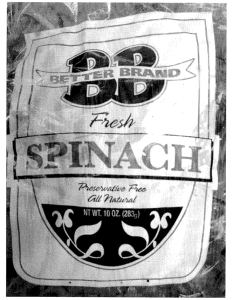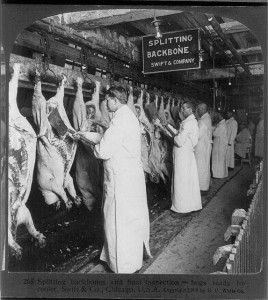Escherichia coli O157:H7 can spread, likely airborne, more than one tenth mile downwind from a cattle feedlot onto nearby produce, according to a paper published ahead of print in Applied and Environmental Microbiology.
 The high percentages of leafy greens contaminated with E. coli suggest great risk for planting fresh produce 180 m [590 feet] or less from a feedlot,” the investigators write. That suggests that current buffer zone guidelines of 120 meters [400 feet] from a feedlot may be inadequate. This is the first comprehensive and long-term study of its kind, says first author Elaine D. Berry, of the U.S. Department of Agriculture, Agricultural Research Service, U.S. Meat Animal Research Center, in Clay Center, Nebraska.
The high percentages of leafy greens contaminated with E. coli suggest great risk for planting fresh produce 180 m [590 feet] or less from a feedlot,” the investigators write. That suggests that current buffer zone guidelines of 120 meters [400 feet] from a feedlot may be inadequate. This is the first comprehensive and long-term study of its kind, says first author Elaine D. Berry, of the U.S. Department of Agriculture, Agricultural Research Service, U.S. Meat Animal Research Center, in Clay Center, Nebraska.
In the study, the investigators sampled leafy greens growing in nine plots; three each at 60, 120, and 180 meters downwind from the cattle feedlot at the research center, over a two year period. The rate of contamination with the pathogenic E. coli O157:H7 declined with distance from an average of 3.5 percent of samples per plot at 60 meters to 1.8 percent at 180 meters.
The researchers sampled the produce six times between June and September of each year. They also sampled the feedlot surface manure in 10 feedlot pens for E. coli O157:H7, finding it in an average of 71.7 to 73.3 percent of samples in 2012 and 2011, respectively. Moreover, the study’s long-term nature enabled sampling under a greater diversity of weather conditions.
A variety of conditions can affect the level of contamination, says Berry. For example, following a period of high cattle management activity when the feedlot was dry and dusty, including removal of around 300 head of cattle for shipping, the rate of total non-pathogenic E. coli-contaminated samples per plot at 180 meters shot up to 92.2 percent.
 Conversely, total E. coli-positive leafy green samples were notably lower on one August sample date than on any other date, a finding the investigators attribute to cleaning and removal of feedlot surface manure from the nearby pens a few weeks earlier.
Conversely, total E. coli-positive leafy green samples were notably lower on one August sample date than on any other date, a finding the investigators attribute to cleaning and removal of feedlot surface manure from the nearby pens a few weeks earlier.
The investigators also found E. coli in air samples at 180 meters from the feedlot, though the instruments were not sensitive enough to pick up E. coli O157:H7. However, the presence of E. coli in the air samples serves as a surrogate for E. coli O157:H7, demonstrating that the pathogen may also be transmitted in this manner, says Berry. The highest levels of contamination found on leafy greens, in August and September of 2012, followed several weeks of very little rainfall and several days of high temperatures, conditions that appear to abet airborne transport of bacteria from the feedlot, she says.
Limitations of the research include that it was conducted only in one state—Nebraska, which is not a produce growing state. Nonetheless, Berry says that the location was a reasonable model for some of the U.S.’s major produce growing regions, such as California’s Central Coast, as winds there can blow almost as hard as in Nebraska, and both places can have dry summers, which are conducive to airborne transport of bacteria.
The impetus for conducting the research was the rising incidence of foodborne disease outbreaks caused by contamination of fresh produce, says Berry.
 Metcash Food & Grocery Ltd has recalled Baker’s Oven Choc Lamingtons 4 Pack from IGA and Independent stores in QLD, Northern NSW and WA due to Staphylococcus aureus contamination.
Metcash Food & Grocery Ltd has recalled Baker’s Oven Choc Lamingtons 4 Pack from IGA and Independent stores in QLD, Northern NSW and WA due to Staphylococcus aureus contamination.










